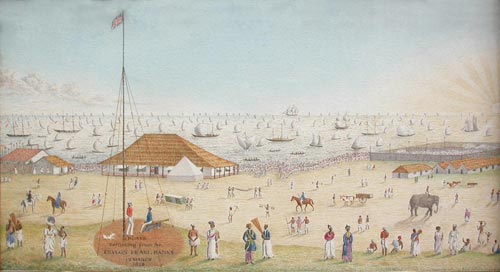The art of Hippolyte Silvaf

The portrait of a Kandyan Chief
His coloured illustrations of fishes of over 400 species were considered by Thomas Huxley, Charles Darwin’s colleague and defender of his radical ideas, as the one of the best ever documentation of marine tropical fishes.
Born on January 8, 1801, Hippolyte Silvaf was described in the press as a French European from Pondicherry. He had migrated to Sri Lanka (Ceylon) during the early 1820s.
During his lifetime he produced a large portfolio of work which encompassed different themes including architecture, costumes, landscapes portraits and above all, natural history subjects.
The origin of the name Silvaf is a curious example of patronymic formed of a familiar Portuguese name. Having the same name as his father, the artist always signed Hippolyte Sylvaf – the letter ‘f’ added to his name as an abbreviation of the French word ‘fils’ meaning `son’. But the public in Sri Lanka misunderstood and ‘f’ was assumed to be a part of his name. He adopted this change permanently and thus the name Silvaf was passed on for generations.
Soon after Hippolyte Sylvaf arrived in this country, he set himself up as a portrait painter and worked in different media including oils, miniatures on ivory and coloured crayons. In the early part of the 19th century, the idea of painting portraits in oils for private sitters and patrons was not in vogue and hardly existed as an art form in Colombo.
In September 1832, he married Wilhelmina Gertrude de Haan and settled down in the Pettah, then a flourishing residential suburb of Colombo. Silvaf’s early career was a struggle trying to eke out an existence from his work as a portrait painter for which he found little patronage from Colombo’s well-to-do society.
![Silvaf--Bottom-Butterfly-Fish[Heinochus-acuminatus]](https://www.sundaytimes.lk/231029/uploads/Silvaf-Bottom-Butterfly-FishHeinochus-acuminatus.jpg)
Master strokes: Documenting tropical marine life in colour. Pic courtesy National Museum, Colombo
By 1839 Silvaf’s dedicated his drawings of the costumes of Ceylon, to Sir Robert Wilmot Horton, who had just retired as Governor of the Colony, as this work was ready for publication. He hoped that such Government patronage would help with the cost of publication and that there would be a demand for his work from private subscribers. With this in view he wrote to Horton in London but received a negative response.
He made several appeals over the next few years to Horton in England, the Ceylon Government and the public, but there was little response. The drawings which were valuable pictorial records of a period of rapid social changes remained unknown and unpublished till a quarter of a century later in 1868, when, 15 select wood engravings of the costumes of Ceylon were published in the work, The Souvenirs of Ceylon, by A.M. Ferguson.
Due to the lack of patronage and the financial failure of his school of drawing, Silvaf and his family moved to Kandy about 1854. He tried a second time to run a school, this time for drawing and music in his house at Brownrigg Street, Kandy. The Times of Ceylon dated April 27, 1855 carried an advertisement by Silvaf that the school would be open on May 1 and that the fees to be charged were two shillings for instruction in music and six shillings for drawing. The notice also indicated that he could do portrait paintings in oils or coloured crayons including the same as miniature paintings on ivory.
The Silvafs were a family of varied talents. Hippolyte’s wife Gertrude and daughter wore both accomplished musicians and they also taught the piano and guitar. His son Napoleon was reputed to be a fine singer.
It was during this period in the 1850’s that the several drawings, paintings and wood engravings of views of Kandy and its environs were done by Silvaf. Everything now seemed grist to his mill; he painted views of bridges, buildings, street scenes, and even the newly constructed railway. In 1857, he sketched the view of the Queen’s palace, which at this time was restored as the residence of the Government Agent, E. R. Power.
He also sketched the drawings for the wood engraving of scenes of the first railway locomotive on its way to Kandy on March 9, 1864. The commemorative souvenir issued for this occasion in 1867 advertised for sale 15 postcard size pictures of the costumes of Ceylon. (They were probably based on the artist’s earlier series). About this period, he also painted a delicate watercolour scene of the Pearl Fisheries Station at Arrippu.

Pearl Fisheries Station at Arrippu: Delicate watercolour
Silvaf was a prolific painter of natural history subjects. His documentation of fishes off the coast of Ceylon was reviewed by Thomas Huxley who considered it as one of the best illustrations of tropical fish species. Several of his mammals and bird drawings came up for sale in the galleries in London, in the 1990s, illustrative of the artist’s skill and remarkable observation of natural history subjects.
Three wood engravings, based on his original sketches were included in Sir Emmerson Tennent’s two-volume work on Ceylon, published in 1859.
A few months ago a London based bookseller put out for sale several coloured drawings by Sylvaf including the opening in 1864 of the Katugastotte Bridge over the Mahaweli Ganga near Kandy
The Illustrated London News carried an article describing the wreck of the English brig the Hebe at the mouth of the Colombo Harbour. Silvaf was commissioned to draw the scene of the wreckage for the engraving. Though the references to works by Silvaf are numerous the works that are extant are few.
He died on April 8, 1879 and was buried in the Roman Catholic Church in Negombo.
Searching for an ideal partner? Find your soul mate on Hitad.lk, Sri Lanka's favourite marriage proposals page. With Hitad.lk matrimonial advertisements you have access to thousands of ads from potential suitors who are looking for someone just like you.


